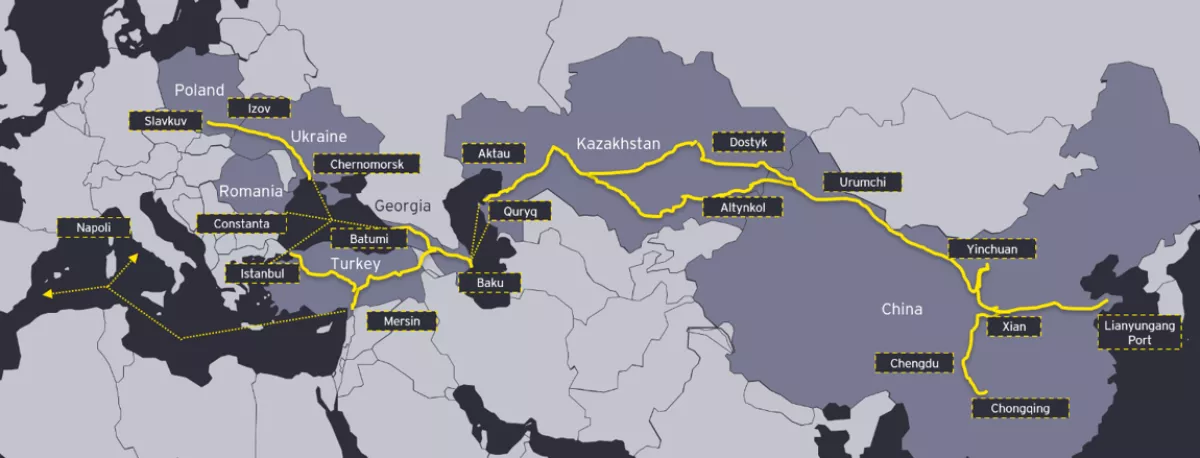Why Iran remains incapable of reaping benefits of its strategic geolocation
Despite its strategic geographic location, Iran’s exposure to sanctions and its regulatory unpredictability have prevented it from integrating into the rapidly evolving trade networks of Central Asia and the South Caucasus.
For years, officials in Tehran maintained confidence that geography would eventually draw Central Asian transport routes southward, arguing that Iran was the most logical gateway to the Indian Ocean and the Persian Gulf. Yet factors beyond distance and terrain have proven far more decisive, as highlighted in a recent article by the National Interest.
Insurance restrictions, sanctions, customs requirements and a range of other practical challenges have pushed Central Asian governments to rethink routes that run through Iran. Many have turned instead to alternatives such as the Middle Corridor via Azerbaijan or long-established transport lines across Russia.
Yet Russia’s war on Ukraine has reshaped that landscape as well. With sanctions tightening, a once-familiar freight route became increasingly unreliable. Cargo that used to move with a single set of documents suddenly required several; insurance premiums rose; border checks slowed; and payments were delayed for opaque reasons.
The growing urgency to diversify pushed the region to revisit the Caspian Sea route — a key component of the Middle Corridor — which carries freight from Kazakhstan or Uzbekistan to ports on the Caspian, then across the water to Azerbaijan, and onward through Georgia and Türkiye into Europe.
Although the article notes that this path comes with its own technical constraints, including winter weather disruptions, ferry schedules and imperfect rail links, it offered the one advantage that mattered most to exporters: distance from Russia. As businesses tested the corridor, momentum grew organically. Freight volumes increased, confidence rose, and investment followed.
“What has changed recently is the scale of investment flowing into this network. Kazakhstan has added capacity at Aktau and Kuryk. Azerbaijan, never shy about infrastructure, has reinforced its maritime terminals and inland logistics hubs. In Georgia, the fixes have been more targeted, mostly on rail sections that long irritated shippers. And the European Union, without much fanfare, has opened new financing windows meant to reduce sanctions exposure across the entire chain,” the article notes.
Central Asian states have not formally turned away from Iran, nor have they felt compelled to reassure Tehran with diplomatic language about the southern corridor. They have simply begun shifting their freight elsewhere — a practical, gradual change that has solidified into habit.
The article also recalls Iran’s own proposal: the International North-South Transport Corridor linking Russia with the Persian Gulf through Iranian and Azerbaijani territory. The Rasht–Astara railway is supposed to complete the link, and each year Tehran and Moscow announce renewed progress, reflected in periodic infrastructure and economic updates. The author acknowledges that the route will matter once finished, but stresses that logistics decisions rarely wait for official statements.
India’s evolving commercial priorities have reinforced this realignment. A decade ago, the Iran–Afghanistan–India concept seemed promising. Today, it no longer fits India’s more urgent trade trajectory toward Europe.
Iran’s internal constraints present another obstacle. Customs procedures change without warning; a document that is required one week may be ignored the next. Diesel shortages interrupt trucking schedules, and exchange-rate volatility makes cost planning difficult for foreign carriers. Domestic businesses in Iran have adapted to these fluctuations, but Central Asian exporters tied to strict European delivery timelines have far less flexibility. Modern supply chains prioritise predictability — something Iran, burdened by accumulated frictions, struggles to offer.
Geopolitics further heighten caution. Central Asian governments prefer to avoid entanglement in conflicts they cannot control. Rising Iran–Israel tensions and broader Middle Eastern instability have been watched with unease in Astana, Tashkent and Ashgabat. The more politically neutral Caspian-based routes therefore feel safer.
Kazakhstan makes this logic particularly visible. Its leadership has strengthened coordination with Azerbaijan, Georgia, Türkiye and European institutions to reinforce westbound transport links. It has diversified its oil export routes for the same reason: not because Iran lacks relevance, but because reliance on any single partner has consistently proven risky.
Uzbekistan, despite being double landlocked, is applying similar reasoning. Its reform agenda hinges on predictable, transparent trade frameworks aligned with WTO practices and attractive to investors from Europe and East Asia. These requirements fit more naturally with a corridor featuring digital customs systems, standardized documentation and greater financial clarity.
The publication notes that Turkmenistan remains characteristically quiet about its intentions, but its port activity provides clues. While maintaining energy exchanges with Iran, it has expanded maritime operations on the Caspian and joined coordination platforms supporting westbound freight. The consistent pattern suggests a search for smoother and more reliable transport pathways.
By Nazrin Sadigova










